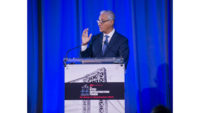Chile’s Quake Likely To Have Minor Impact on U.S. Practice
The behavior of engineered structures in the magnitude-8.8 Maule earthquake that struck Chile on Feb. 27 is unlikely to lead to big changes in U.S. practice or codes, agree engineers.

“The performance of modern engineered construction in the quake was quite good, and most instances of poor performance are associated with differences in Chilean and U.S. design practice,” said Ronald O. Hamburger at the 2010 National Council of Structural Engineers Associations conference, held from Sept. 30 to Oct. 2 in Jersey City, N.J. Hamburger, a senior principal in the San Francisco office of Simpson Gumpertz & Heger, was part of a 15-engineer assessment team that visited Chile in March.
Engineers will study the quake, he said. They are interested in how Chile’s concrete structures behaved during the two minutes of strong ground-shaking, a long period compared to the 20-second length of recent strong U.S. temblors.
They also are interested in confinement issues related to concrete shear-wall failures in tall residential buildings. The failures led to a few collapses and left many high-rises with large permanent lateral drifts, on the order of 3%, which made them uninhabitable. “This has been traced to Chilean codes that do not require the closely spaced confinement reinforcing typically provided in U.S. designs,” said Hamburger.
But an area of concern regarding the U.S. concrete code is that it permits construction of walls without confinement reinforcing if axial loads are suitably small. U.S. code groups will be evaluating whether this should be changed, he said.
Ground motions from the Chilean quake suggest U.S. code requirements for design forces for high-rise buildings may be too conservative. It may be possible to design very tall buildings more economically, said Hamburger.
U.S. engineers who view recent anchor-bolt strength provisions in the U.S. concrete code as excessively conservative may have ammunition from the Chile quake to explore relaxing the code. In Chile, the bolts, which are not subject to the U.S. code change, performed well during the quake, said Hamburger.
Seismographs recorded copious strong-motion data in the Maule quake. These records will allow U.S. researchers to re-evaluate attenuation equations used to predict ground-motion intensity as a function of magnitude and distance, particularly for subduction zones. Researchers may refine seismic hazard maps in areas—such as the Northwest—affected by subduction events, said Hamburger.
In Chile, many high-rise apartment-unit doors jammed shut, trapping occupants, because of damage to lightly reinforced link beams above doorways. Hamburger thinks similar jamming may occur during moderate seismic events in cities such as New York, Boston and Sacramento, Calif.
The Structural Engineers Association of New York (SEAoNY), which organized the conference, is trying to spread the word about another disaster-related issue: immunity from professional liability during emergencies, such as search-and-rescue operations. In some states, engineers are protected by Good Samaritan laws, but not if they are paid.
In the aftermath of the Sept. 11, 2001, World Trade Center attacks, nearly 20,000 plaintiffs filed lawsuits against New York City and its contractors. The suits, which charge a failure to provide a safe workplace because of poor air quality, name 21 structural engineering firms.
SEAoNY has failed to find a legislator at the state or federal level to aid its members by passing a law to indemnify them. The group now is trying to raise awareness among its colleagues across the U.S.
On Nov. 4, Ramon Gilsanz, whose firm Gilsanz Murray Steficek was named in the suits, will travel to Billings, Mont., to talk to his engineering counterparts. “We went there to help, and we are getting sued over something we had no control over and were exposed to ourselves,” he said.




